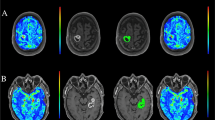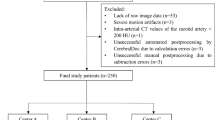Summary
A multisclice gradient echo sequence (FLASH) was compared with a conventional spin-echo (SE) technique with regard to its value for contrast enhanced brain studies. In 50 patients with contrast enhancing intracranial lesions, MR studies (0.5 Tesla MR tomograph) were performed with SE images (SE 400/30; four images/3.4 min) and FLASH scans (FLASH 315/14, 90°; 15 images/1.4 min) before and after Gd-DTPA. Based on visual and quantitative assessment diagnostic results of postcontrast SE- and FLASH images were equivalent with respect to contrast enhancement, lesion/brain-contrast, lesion/edema-contrast, and lesion delineation. Although image quality generally was excellent on postcontrast FLASH images, susceptibility artifacts were more severe on FLASH scans than on SE images. However, with the exception of postoperative patients with artifacts due to metal remains, diagnostic information was not decreased by artifacts on postcontrast FLASH images. In conclusion, because of the clearly higher efficiency of the multisclice FLASH technique, this pulse sequence offers the opportunity to speed up contrast enhanced brain imaging.
Similar content being viewed by others
References
Brant-Zawadzki M, Berry I, Osaki L, Brasch R, Murovic J, Norman D (1986) Gd-DTPA in clinical MR of the brain: 1. Intraaxial lesions. AJNR 7: 781–788
Carr DH, Brown J, Bydder GM, Weinmann HJ, Speck U, Thomas DJ, Young UR (1984) Intravenous chelated gadolinium as a contrast agent in NMR imaging of cerebral tumors. Lancet 1: 484–486
Felix R, Schörner W, Laniado M, Niendorf HP, Claussen C, Fiegler W, Speck U (1985) Brain tumors: MR imaging with gadolinium-DTPA. Radiology 156: 681–688
Schörner W, Laniado M, Kornmesser W, Felix R (1989) Comparison of multi-echo and contrast enhanced MR scans: image contrast and delineation of intracranial tumors. Neuroradiology 31: 140–147
Laniado M, Niendorf HP, Sehömer W, Felix R (1986) Spin-echo and inversion-recovery sequences for gadolinium-DTPA-enhanced MRI of intracranial tumors. Acta Radiol [Suppl] 369: 469–471
Price AC, Runge VM (1986) Optimization of pulse sequence in Gd-DTPA enhanced magnetic resonance imaging. In: Runge VM, Claussen C, Felix R, James AE (eds) Contrast agents in magnetic resonance imaging. Excerpta Medica, Princeton, pp 99–102
Utz JA, Herfkens RJ, Johnson CD, et al. (1987) Two-second MR images: comparison with spin echo images in 29 patients. AJR 148: 629–633
Haase A, Frahm J, Mathaei D, Hänicke W, Merboldt KD (1986) FLASH imaging. Rapid NMR imaging using low flip-angle pulses. J Magn Reson 67: 217–225
Van der Meulen P, Groen JP, Cuppen JJ (1985) Very fast MR imaging by field ethos and small angle excitation. Magn Reson Imag 3: 297–299
Mills TC, Ortendahl DA, Hylton NM, Crooks LE, Carlson JW, Kaufman L (1987) Partial flip angle MR imaging. Radiology 162: 531–539
Stadnik TW, Luypaert RR, Neirynck EC, Osteaux M (1988) Optimization of sequence parameters in fast MR imaging of the brain with FLASH. AJNR 10: 357–362
Winkler ML, Ortendahl DA, Mills TC, Crooks LE, Sheldon PE, Kaufman L (1988) Characteristics of partial flip angle and gradient reversal MR imaging. Radiology 166: 17–26
Koschorek FG, Jensen HP, Terwey B (1986) Gd-DTPA-enhanced dynamic magnetic resonance imaging of brain lesions: preliminary results: In: Runge VM, Claussen C, Felix R, James AE (eds) Contrast agents in magnetic resonance imaging. Excerpta Medica, Princeton; pp 129–131
Sander B, Kornmesser W, Felix R (1987) Improved clinical application of FLASH imaging using multi slice technique. Presented at the Topical Conference on Fast Magnetic Resonance Imaging Techniques, 15–17.5.1987, Cleveland
Hart HR, Bottomley PA, Edelstein WA, Karr SG, Leue WM, Mueller O, Redington RW, Schenck JF, Smith LS, Vatis D (1983) Nuclear magnetic resonance imaging: contrast-to-noise ratio as a function of strength of magnetic field. AJR 141: 1195–1201
Runge VM (1988) Clinical applications of 3-D fast imaging. Sixth annual meeting of the Society of Magnetic Resonance Imaging, Boston
Hinshaw DB, Holshouser BA, Engstrom HIM, Tjan AHL, Christiansen EL, Catelli WF (1988) Dental material artifacts on MR images. Radiology 166: 777–779
Author information
Authors and Affiliations
Rights and permissions
About this article
Cite this article
Schörner, W., Sander, B., Henkes, H. et al. Multiple slice FLASH imaging: An improved pulse sequence for contrast enhanced MR brain studies. Neuroradiology 32, 474–480 (1990). https://doi.org/10.1007/BF02426458
Received:
Issue Date:
DOI: https://doi.org/10.1007/BF02426458




